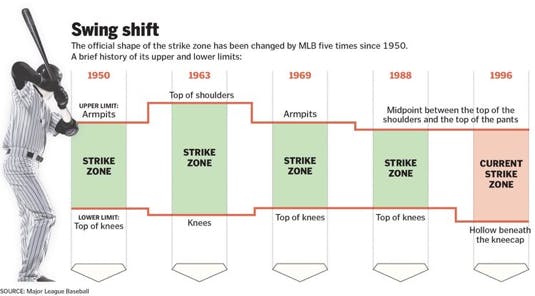After an incredible year of baseball that finally put the Cubs World Series curse to rest, the MLB has set out to make some major changes in the way the game is played.
By Leighann Strollo 2/10/17
Baseball fans have heard for years now, that changes to the strike zone and intentional walk rules were changing in the off-season. As of Monday, Feb. 6, ESPN reported that Major League Baseball made an official proposal to the player’s union to change a few rules. This would affect the intentional walk rule, making it so pitchers wouldn’t have to throw four pitches if they wanted to intentionally walk a batter and to raise the strike zone.

Since 1996, the strike zone has been defined as the area from the bottom of the kneecap to a horizontal line across the chest of the batter. This change would raise the bottom of the strike zone to the top of the kneecaps instead. MLB claims that this will result in more balls hit into play, but it could also have a dangerous affect on the way pitchers train their low pitches.
It comes as no surprise with all the efforts made by current commissioner, Rob Manfred, to speed up the average game time and try to engage a younger audience by making the game go by faster.
A key element of the game could be lost by adhering to high school baseball rules of the intentional walk though. An old baseball proverb states that if you stick around long enough, you’ll see something you’ve never seen before. And it’s true.
Most of the time, pitches in an intentional walk are tossed far outside the strike zone, and the batter makes no attempt at them as they are clearly balls. However, occasionally something doesn’t go quite right, like a wild pitch or the pitcher letting the ball fly a little too close to the strike zone and the batter could still end up with a hit, or in some cases, scoring a run. By eliminating the four pitches, those games could have had vastly different outcomes.
The game of baseball is criticized a lot for being a slow, and boring game mainly watched by an older generation of sports fans. However, if 2016 proved anything, it’s that baseball is still alive and well among younger people. Cammie French, an IUPUI student and diehard Cubs fan, proves that to be true.

“My grandpa has been a Cubs fan his entire life so growing up that's all I knew. We go to a game every year since I can remember so he says it's in my blood.” she said, at 21 years old, never having witnessed the Cubs make it to a World Series until 2016. “I’m even getting my first tattoo dedicated to them soon.”
Game 7 of the World Series between the Chicago Cubs and the Cleveland Indians, the two teams with the longest World Series droughts, brought in 40 million viewers to their extra innings, rubber match. That’s the highest viewership has been for a baseball game in 25 years.
So my question to Rob Manfred would be, do we really need to speed up the game?
The interest in baseball isn’t lost in the few extra minutes it takes to throw four balls, or the time it takes to review a play when a challenge is made. The decline in interest in baseball stems from America’s distrust of baseball players during the steroid era, and the rise in popularity of the NFL. We’ve come to terms with the fact that baseball isn’t the most prominent sport in America anymore, but there are still dedicated fans and players who wouldn’t at all benefit from a change in the game. If anything the MLB is only risking losing fans from this decision, and with Spring Training games set to begin Feb. 22, they better make it quick.
2017 Baseball Season Might See Drastic Changes in Gameplay

Heads up! This article was imported from a previous version of The Campus Citizen. If you notice any issues, please let us know.
@cammiefrench Best days of my life tbh




